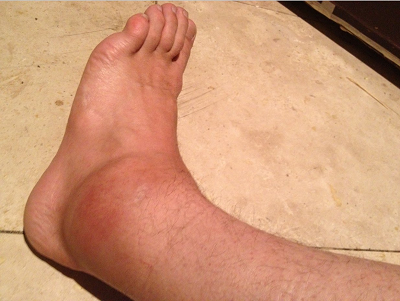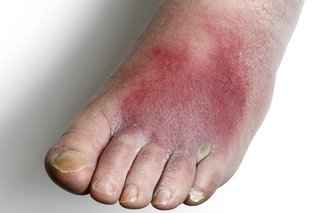One Ankle Swelling (left or Right Foot): Causes, Treatment

Last updated on July 26th, 2018 at 04:37 pm
Question: What causes one ankle swelling? Are there home remedies for painfully swollen right or left ankle?
Your ankles support your legs, carry the weight of your entire body and are important for movement. Any injury to your ankle joint may cause swelling and pain of one or both ankles.
If you experience swelling of one ankle joint, it is crucial you see your doctor. In mild cases, you may have a minor knock that causes pain and mild swelling. If this is the case, swelling may resolve in a few days.
However, there is a risk that your ankle swelling is life-threatening. In some cases, ankle and calf swelling may be due to deep venous thrombosis (DVT). DVT is a serious medical condition when clots forms inside your veins, especially in your calf and legs. If this happens, there is a risk of pulmonary embolism that occurs if clot detaches and travel to lungs.
Another serious reason for one ankle swelling is a skin infection. Infection of the skin, medically referred to as cellulitis, can cause ankle swelling if you have a laceration or cut on your skin. If this happens, you will have swelling affecting only one ankle.
The truth is, many factors can trigger leg, ankle and foot swelling. If you smoke, there is a possibility you already have a serious illness. Smoking is a major risk factor for the formation of blood clot in your veins.
Other risk factors are high blood pressure, diabetes, elderly men and women over 60 years, chronic alcoholism, cancer, and obesity.
Also, your lifestyle could be affecting your health and could cause your ankle to swell. In some cases, ankle swells up after sitting, walking or standing for long hours.
Therefore, because of the risk involved, and how difficult it is to determine the cause on your own, it is essential to see your doctor for help
Here are some questions to expect
- When did you notice swelling of your ankles?
- Do you experience swelling of the other ankle too?
- Is the swelling on your ankle compressible?
- Did you fall or twist your ankle while walking, running, jogging or playing a sports game?
- Do swelling come and go or have been persistent and getting worse?
- Is there anything that makes your swelling go away?
- Is there anything that makes your ankle swelling worse?
This article explains causes of left or right ankle swelling and what to do to feel okay.
What causes one Ankle swelling (left or right)?
If you developed swelling on one of your ankles, its normal you will be worried and want quick answers. Here are the common causes of only one ankle swelling
1. Ankle Sprain
Trauma to your ankle bones, ligament or tendon, can cause swelling. If you just had an accident or twisted your ankle joint, swelling may be due to an ankle sprain.
Ankle sprain means your ligaments that provide stability to the ankle is inflamed. In severe cases, the ligament is torn causing joint instability. Symptoms of a sprained ankle are swelling, pain, inability to walk, and stiffness.
 If you have an ankle sprain, it is essential to see your doctor. This is necessary to assess the extent of the injury. While planning to see your doctor, The RICE protocol is an effective treatment. These basic recommendations help in reducing your pain and prevents your injury from getting worse.
If you have an ankle sprain, it is essential to see your doctor. This is necessary to assess the extent of the injury. While planning to see your doctor, The RICE protocol is an effective treatment. These basic recommendations help in reducing your pain and prevents your injury from getting worse.
- Rest your leg, foot, and ankle. This is important to avoid further injury to your ligament and bones
- Get ice and apply at the site of injury. This will also help with your swelling and alleviate pain (please, do not use ice directly on your skin).
- Apply an elastic bandage to quickly compress your ankle swelling
- Raise your ankle above your heart level. This is a simple but effective technique that helps heal your swollen foot.
Take Non-steroidal Anti-Inflammatory Drugs to help with the pain. An ankle sprain can cause excruciating pain, and you will need a quick relief of symptoms. Medications like ibuprofen or naproxen will make you calm.
2. Ankle joint inflammation
Besides a sprain, if you develop swelling of one ankle with pain, it could be due to osteoarthritis. Then again, osteoarthritis can affect other joint too. So, if you feel pain in your hip, knee, or both ankles, its likely due to arthritis.
In simple terms, osteoarthritis means breakdown or loss of joint cartilages at your ankle joint. The bone cartilage is vital in providing cushioning effect by preventing bones from rubbing against each other.
If cartilage at your ankles gets worn out, it causes direct contact of bones at the joint. This can cause mild or severe swelling and pain of one ankle.
Risk factors for osteoarthritis vary among individuals, though obesity and old age are the main predisposing factors. Other risk factors are bone deformity, prior injury to your ankle joint, previous joint surgery, and jobs that make you use a particular joint all the time.
Symptoms of osteoarthritis are stiffness of your joint, decreased flexibility, rigidity at joint after resting for a while, ankle pain, grating sound during movement, and swelling of the ankle.
Treatment of osteoarthritis will depend on the severity of the inflammation. The goal is to reduce the tenderness and pain at your joint and improve joint flexibility.
Weight loss, exercise, painkiller tablets or cream can make you feel okay. See your doctor for further treatment options.
3. Deep vein thrombosis
Deep vein thrombosis, or DVT as it is commonly called, is the formation of clot within your deep veins. If you have swelling of one leg, there is a chance it could be DVT.
Though rare, a Deep vein thrombosis affects 2 in 1000 people in the United States. While a lot of people with a blood clot will have no symptoms, it could become fatal if clot moves through your blood and block the pulmonary artery (Pulmonary embolism).
Symptoms of DVT are pain and swelling of your calf, leg, and ankle.
What to do for a DVT?
Because DVT could be fatal or cause life-threatening complications (pulmonary edema), it is crucial you talk to your doctor as soon as possible. Your doctor will quickly ask you some questions and also examine your musculoskeletal, respiratory and cardiovascular systems. If you smoke, it is important you tell your doctor too.
Investigations will be carried out; They include an ultrasound, D-Dimer test, CT scan and an MRI to detect affected veins.
Treatment options are available. However, the aim is primarily preventing small clots from growing bigger. Your doctor will prescribe blood-thinning medications that reduce your chances of forming clots. In severe cases, thrombolytic drugs (clot breakers) are prescribed to break down already formed clots.
It is important you do not take medications on your own. These medications can cause severe bleeding due to interfering with the normal clotting mechanism. It is best to see your doctor to decide what works best for you.
Also, regularly following up with your check up prevents complications. In some instance, the time it takes for your blood to clot is continually monitored. It is best you follow your doctor advice and clinic appointments.
4. Ankle infections
Skin infections in your lower extremities can cause a swollen ankle. A swollen, red-looking, inflamed ankle after a cut, insect bite, laceration or break in skin surface may be due to skin infection.
Doctor refer skin infection as cellulitis, and it is caused by bacterial infection. Symptoms are fever (high body temperature), redness, pain and swelling of right or left ankle, or an overlying skin sore.
 The truth is, cellulitis is more likely to happen if your immune system is weakened. Other factors that increase your chances of developing skin infection are Diabetes Mellitus, HIV infection, and persistent IV drug use.
The truth is, cellulitis is more likely to happen if your immune system is weakened. Other factors that increase your chances of developing skin infection are Diabetes Mellitus, HIV infection, and persistent IV drug use.
Depending on the severity of the infection, medications will be prescribed for a long time, sometimes lasting for three weeks. Drugs are antibiotics and painkillers to help with pain. If there is a sore on your ankle, your doctor will request for daily wound dressing.
What happens if cellulitis is left untreated?
If you see your doctor early enough, its unlikely cellulitis will worsen. Untreated or poorly treated cellulitis of the ankle joint can cause pus accumulation.
If this happens, you must need surgery to drain out pus while still on antibiotics.
FREQUENTLY ASKED QUESTIONS
One swollen ankle for no reason, why?
If you think your ankle is swollen for no reason, you may be incorrect. A heart, kidney, liver disease can cause the swelling of your ankle without any physical insult.
If you have osteoarthritis, swelling of the ankle is a sign. It is important you see your doctor to be sure its nothing serious.
One swollen ankle no pain, why?
Swelling of one ankle without pain may also be due to heart and kidney disease. Swelling of the extremities or peripheral edema can affect one or both ankles. Systemic illnesses usually do not cause pain.
What causes one swollen ankle with pain?
If you feel pain and swelling in your ankle, it could be due to an underlying problem. Causes are an ankle sprain, arthritis, direct leg trauma, gout, baker’s cyst, and thrombosis of deep veins.
Talk to your doctor
What causes right ankle swelling?
Swelling of the right ankle only can happen for the above-listed reasons. Ankle sprain, osteoarthritis, Deep vein thrombosis, gout, dislocation, fracture of the lower tibia or fibula bones, fracture of the talus or calcaneus, and cellulitis.
What causes left ankle swelling only?
Swelling of the left ankle and foot may be due to
- Ankle Sprain
- Fracture
- DVT
- Arthritis
- Skin infections
